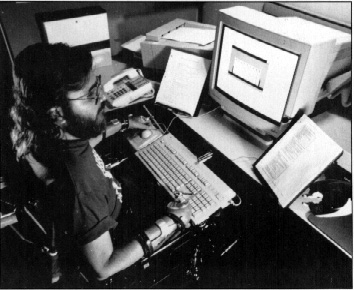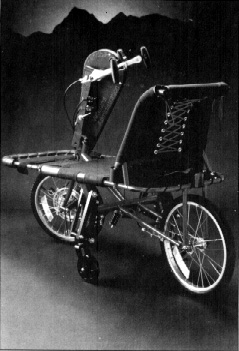
Department of Veterans Affairs
Research News
September - October, 1997 (pages 4 and 5)
Rehabilitation Research in
Palo Alto
Center Concentrates on Mobility
by Patricia S. Forsyth
Since it opened in 1978, the VA Palo Alto Health Care
System's Rehabilitation Research and Development Center has become well-known
for innovative clinical treatments and technological devices for physically
disabled veterans and the entire community.
Felix Zajac, PhD, is engineering and scientific director,
Charles Burgar, MD, serves as medical director, and Dennis Carter, PhD, is
associate director. Dr. Zajac has a strong interest in motor control research
and Dr. Carter, a mechanical engineer, in how bone and cartilage change in
response to stress, Dr. Burgar pointed out, while he himself is a clinician
specializing in physical medicine and rehabilitation. "That sets the tone
for what we do here," Dr. Burgar said.
Focus on Mobility
The center's overall focus is on mobility; especially how
physical forces can he used to affect mobility in people who have been impaired
by stroke, spinal cord injury, arthritis, osteoporosis, and other conditions.
Basic research projects are underway to improve understanding of how the
nervous system controls muscles and how gone grows and regenerates itself.
Center researchers also collaborate closely with clinicians at the Palo Alto VA
and Stanford University medical centers and other clinical centers. "This
helps us ensure relevance of our research and clinically test our treatments
and devices," Dr. Burgar noted.
One center project is designed to help post-stroke
patients reduce the likelihood of falling as they regain coordination after a
stroke by testing their ability to step over virtual" obstacles. The
patient wears a visor-like device with a tiny TV screen built in to simulate
negotiating a path with obstacles. "The advantage is that there is no fall
if the patient fails to clear a virtual object," Dr. Burgar said.
"This can he used for training and also as a test to see how well patients
are learning." Physical therapist David A. Brown, PhD, and biomedical
engineer David L. Jaffe, MS head the project.
Another project is a collaboration with the National
Aeronautics and Space Administration. NASA has an obvious interest in the
effect of micro gravity on exercise, Dr. Burgar pointed out. During space
flight, astronauts experience declines in many body systems, including loss of
bone strength. Because exercise may help maintain muscle and bone during space
flight, a team led by NASA researcher Robert Whalen, PhD, has developed a
system using an exercise treadmill, an acrylic tent-like device sealing the
system around a user's waist and legs, and an ordinary industrial vacuum
cleaner that uses suction as a substitute for gravity to hold the astronauts
onto the tread as they walk.
"Of course that is not what I need when I get a
patient newly out of bed," Dr. Burgar pointed out. "We decided if you
can pull a person down with this device perhaps you can lift somebody up, and
it turns out you can." By reversing the vacuum, researchers found they
could apply enough pressure to lift people's weight off their feet. "It's
like the machine is trying to spit them out the top like a champagne
cork," Dr. Burgar said. "It simulates micro gravity, and we can make
patients feel like they are walking on the moon."
Because the pressure can be controlled, he emphasized,
each patient can bear as much weight as possible while walking, with the
machine supplying the rest of the lift that traditionally must be provided by
parallel bars or a therapist. "Using this device, we hope to be able to do
gait training very early after a neurological injury, Dr. Burgar said.
Mechanical Manipulation
 A student with a spinal cord injury uses a
robot-equipped workstation in a desktop publishing course at the Rehabilitation
Research and Development Center in Palo Alto.
(Photo by Curt Campbell, VA Palo Alto Health Care System)
A common theme in many center projects is use of
mechanical manipulation to restore or maintain muscle and bone function. By
providing appropriate sensory input, the researchers can influence the way in
which the nervous system reorganizes itself after injury. They are using
mathematical computer models to help them understand complex neuromuscular
systems. One project focuses on how muscles are activated. Using a pedaling
device, the researchers can measure activation and how muscles work to achieve
a particular motion. A bicycle-like device resulting from this project helps
patients learn to walk again after neurological injury. In this project, led by
Dr. Brown and Steven A. Kautz, PhD, the cycle can be rotated to different
positions that allow a weak person to begin strengthening exercises lying
down.
Another center project addresses the problem of upper
limb strength after a stroke. For many stroke patients, losing the ability to
drive decreases their quality of life. The Palo Alto researchers have developed
techniques to measure how much force each hand provides to each side of a
steering wheel and to train patients to use the weaker side more effectively.
Michelle Johnson, MS, a doctoral candidate at Stanford, is working with center
investigators on this project. To enhance rehabilitation training, the center
is equipped with a gymnasium similar to standard physical therapy gyms and has
a staff of physical and occupational therapists.
Another important facet of the center is its laboratory
for testing the effects of different loads on actual bone or materials
formulated to behave like bone. This laboratory, led by Dr. Carter and Gary
Beaupré, PhD, is currently studying cartilage growth. A common
"wear and tear" problem of aging is osteoarthritis resulting from
breakdown of joint cartilage. Although recent studies elsewhere have shown that
human cartilage cells can be grown in the laboratory and then reinserted in to
arthritic joints, these laboratory-cultured cells may fail to produce the
optimal kind of cartilage. Lane Smith, PhD, and colleagues are attempting to
determine how cartilage-cell genes can be turned on to create the right type of
cartilage. "We want to establish how genes in cartilage cells can be
turned on to create the right kind of cartilage," Dr. Burgar said.
"This is a bit more basic research than many of our center projects, but
we expect it to end up in the clinics within five to ten years.
New Devices
 The
Handbike arm-powered bicycle is among the devices developed at the
Rehabilitation Research and Development Center in Palo Alto. (Photo by Curt Campbell, VA Palo Alto Health Care
System)
A major focus of the center is in development of devices
that supplement research aims of other projects or that may directly benefit
patients. One such device, is a hand bike designed for people with lower limb
disability. All power, steering, and braking done by hand. This effort
initially was a student project in the Stanford design division of mechanical
engineering, Dr. Burgar noted. The bike, which is now commercially available,
began as a project by Stanford mechanical engineering student Doug Schwandt, MS
who continued its development at the Rehab R&D Center.
Another device is the head-controlled wheelchair
developed by biomedical engineer David L. Jaffe. The chair uses ultrasound and
allows users to steer by leaning their heads. Other examples of products
developed at the center that have been brought to market to benefit veterans
and others with disabilities include the Handtyper, a sturdy, lightweight
typing aid for persons with limited hand function, developed by a team led by
occupation therapist Stephanie O'Leary. The Lingraphica portable assistive and
therapeutic communications device for people with aphasia from stroke or other
brain injury was designed by Richard Steele, PhD, and colleagues. Kevin McGill,
PhD, developed a computer program for analyzing clinical electromyograms.
Another center innovation is a program focusing on
techniques to help disabled people go back to work, such as the use of robots
as work station assistants for quadriplegics. Using this and similar devices,
Machiel Van der Loos, PhD, has developed courses for desktop publishing and
related skills. "Most of our students had no computer skills when they
came in," Dr. Burgar said, "but most found employment. In fact, we
hired one of these students ourselves."
 |